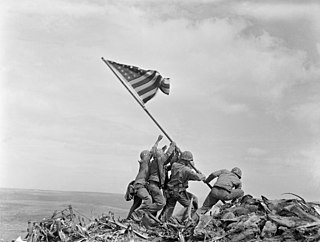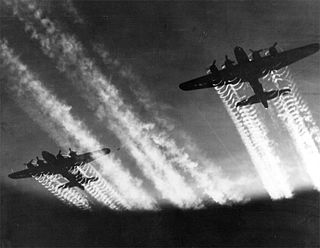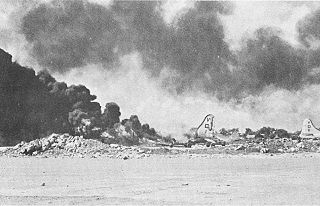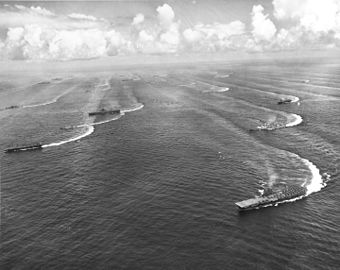
The Battle of Okinawa, codenamed Operation Iceberg, was a battle of the Pacific War fought on the island of Okinawa by United States Army and United States Marine Corps forces against the Imperial Japanese Army. The initial invasion of Okinawa on 1 April 1945 was the largest amphibious assault in the Pacific Theater of World War II. The Kerama Islands surrounding Okinawa were preemptively captured on 26 March by the 77th Infantry Division. The 82-day battle lasted from 1 April until 22 June 1945. After a long campaign of island hopping, the Allies were planning to use Kadena Air Base on the large island of Okinawa as a base for Operation Downfall, the planned invasion of the Japanese home islands, 340 mi (550 km) away.

The Battle of Iwo Jima was a major battle in which the United States Marine Corps (USMC) and United States Navy (USN) landed on and eventually captured the island of Iwo Jima from the Imperial Japanese Army (IJA) during World War II. The American invasion, designated Operation Detachment, had the purpose of capturing the island with its two airfields: South Field and Central Field.

Iwo Jima, now officially romanized Iōtō, is one of the Japanese Volcano Islands, which lie south of the Bonin Islands and together with them make up the Ogasawara Archipelago. Together with the Izu Islands, they make up Japan's Nanpō Islands. Although 1,200 km (750 mi) south of Tokyo on Honshu, Iwo Jima is administered as part of the Ogasawara Subprefecture of the Tokyo Metropolitan Government.

Operation Downfall was the proposed Allied plan for the invasion of the Japanese home islands near the end of World War II. The planned operation was canceled when Japan surrendered following the atomic bombings of Hiroshima and Nagasaki, the Soviet declaration of war, and the invasion of Manchuria. The operation had two parts: Operation Olympic and Operation Coronet. Set to begin in November 1945, Operation Olympic was intended to capture the southern third of the southernmost main Japanese island, Kyūshū, with the recently captured island of Okinawa to be used as a staging area. In early 1946 would come Operation Coronet, the planned invasion of the Kantō Plain, near Tokyo, on the main Japanese island of Honshu. Airbases on Kyūshū captured in Operation Olympic would allow land-based air support for Operation Coronet. If Downfall had taken place, it would have been the largest amphibious operation in history, surpassing D-Day.

The Pacific War, sometimes called the Asia–Pacific War, was the theater of World War II that was fought in eastern Asia, the Pacific Ocean, the Indian Ocean, and Oceania. It was geographically the largest theater of the war, including the vast Pacific Ocean theater, the South West Pacific theater, the Second Sino-Japanese War, and the Soviet–Japanese War.

USS Bataan (CVL-29/AVT-4), originally planned as USS Buffalo (CL-99) and also classified as CV-29, was an 11,000 ton Independence-class light aircraft carrier which was commissioned in the United States Navy during World War II on 17 November 1943. Serving in the Pacific Theatre for the entire war, taking part in operations around New Guinea, the Invasion of the Mariana Islands, the Battle of the Philippine Sea, the Battle of Okinawa, and Attacks on the Japanese home islands. After World War II's end she was converted into an anti-submarine carrier and placed in reserve on 11 February 1947.

USS San Jacinto (CVL-30) of the United States Navy was an Independence-class light aircraft carrier that served during World War II. She was named for the Battle of San Jacinto during the Texas Revolution. Future U.S. President George H. W. Bush served aboard the ship during World War II.

USS Makin Island (CVE-93) was a Casablanca-class escort carrier of the United States Navy. It was named for the 1942 Makin raid, an early diversionary raid designed to distract from the Guadalcanal campaign and the Tulagi campaign. Launched in April 1944, and commissioned in May, she served in support of the Philippines campaign, the Invasion of Iwo Jima, and the Battle of Okinawa. Postwar, she participated in Operation Magic Carpet. She was decommissioned in April 1946, and ultimately sold for scrapping in January 1947.
This is a list of aviation-related events from 1945:

Giretsu was an airborne commando unit of the Imperial Japanese Army formed from Teishin Shudan, in November 1944 as a last-ditch attempt to reduce and delay Allied bombing raids on the Japanese home islands. The Giretsu commando unit was commanded by Lieutenant General Michio Sugahara.

USS Healy (DD-672) was a Fletcher-class destroyer of the United States Navy.

The military history of the United States during World War II covers the nation's role as one of the major Allies in their victory over the Axis Powers. The United States is generally considered to have entered the conflict with the 7 December 1941 surprise attack on Pearl Harbor by the Empire of Japan and exited it with the 2 September 1945 surrender of Japan. During the first two years of World War II, the US maintained formal neutrality, which was officially announced in the Quarantine Speech delivered by US President Franklin D. Roosevelt in 1937. While officially neutral, the US supplied Britain, the Soviet Union, and China with war materiel through the Lend-Lease Act signed into law on 11 March 1941, and deployed the US military to replace the British forces stationed in Iceland. Following the 4 September 1941 Greer incident involving a German submarine, Roosevelt publicly confirmed a "shoot on sight" order on 11 September, effectively declaring naval war on Germany and Italy in the Battle of the Atlantic. In the Pacific Theater, there was unofficial early US combat activity such as the Flying Tigers.

The Volcano and Ryūkyū Islands campaign was a series of battles and engagements between Allied forces and Imperial Japanese forces in the Pacific Ocean campaign of World War II between January and June 1945.

During World War II, Allied forces conducted air raids on Japan from 1942 to 1945, causing extensive destruction to the country's cities and killing between 241,000 and 900,000 people. During the first years of the Pacific War these attacks were limited to the Doolittle Raid in April 1942 and small-scale raids on military positions in the Kuril Islands from mid-1943. Strategic bombing raids began in June 1944 and continued until the end of the war in August 1945. Allied naval and land-based tactical air units also attacked Japan during 1945.

Substantial debate exists over the ethical, legal, and military aspects of the atomic bombings of Hiroshima and Nagasaki on 6 August and 9 August 1945 at the close of World War II (1939–45).

USS Briscoe (APA-65) was a Gilliam-class attack transport that served with the United States Navy from 1944 to 1946. She was sunk as a target in 1948.
This is a timeline of the events that stretched over the period of late World War II, its conclusion and legal aftermath, from January 1945 to 1991.

During World War II, a series of Japanese air attacks on the Mariana Islands took place between November 1944 and January 1945. These raids targeted United States Army Air Forces (USAAF) bases and sought to disrupt the bombing of Japan by Boeing B-29 Superfortress heavy bombers operating from the islands. The Japanese lost 37 aircraft during this operation, but destroyed 11 B-29s and damaged a further 43. Preparations were also made for commando raids on the bases in early and mid-1945 but these did not go ahead.
The following events occurred in March 1945:
The Bombing of Kumagaya in World War II on 14 August 1945, was part of the strategic bombing campaign waged by the United States of America against military and civilian targets and population centers during the Japan home islands campaign in the closing stages of World War II.

















